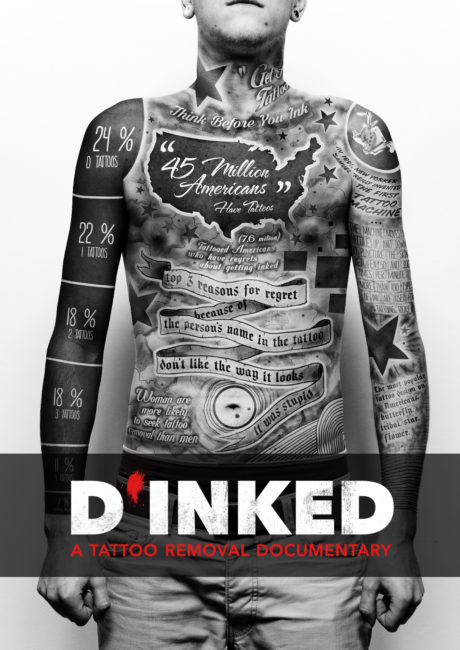 Many in reentry are determined to get their unwanted tattoos removed, so they can find employment and start a new life. But what’s the process really like?
Many in reentry are determined to get their unwanted tattoos removed, so they can find employment and start a new life. But what’s the process really like?
In their recently released documentary D’Inked, filmmakers Jacob Tillman and Ben Pierce take viewers on a journey through the world of tattoo removal. They examine the development of laser tattoo removal technology and how it has changed the culture of tattoos.
We meet people who’ve had their tattoos taken off, both professionally and through their own efforts. And some were disasters. Like the guy who attempted to remove his face tattoo with a soldering iron and a woman whose laser mistreatment produced giant sized blisters.
The focus, however, is on Tillman himself – Director Pierce has no tattoos – as he documents his five-year effort to have a full color half sleeve tattoo removed and covered up.
The tattoos that make up the half sleeve are just three of Jacob’s eight tattoos. He had the one on his ring finger taken off without numbing cream so he’d remember the fact that “he’s an idiot and shouldn’t have gotten it done.”
But the main work was the half sleeve, which he said was a mistake from the beginning. “I got the tattoo in 2009-2010. I knew instantly when I got the very last one that I wanted it removed, so in 2011 I started doing research and discovered there weren’t that many places out there (doing removals) at the time.
“After a lot of research, we ended up at Rethink the Ink in Denver with the Quanta laser.” For the next 3-1/2 years Tillman flew to Denver for the 16 treatments required and after that looked for a tattoo artist to do a cover-up. He found that person in San Diego.
In addition to the footage of some of his many treatments, the film includes Interviews with dozens of tattoo artists and laser technology industry leaders. The interviews highlight the fact that tattoo removal is becoming a totally acceptable practice – although for the clients, it’s a long and painful process.
Reasons Tillman and Pierce decided to make D’Inked
So why did they decide to make a documentary?
“There are a lot of reasons,” Tillman says. “I felt if I was going through this I wanted something positive to come out of it. I thought people would see the film and say it’s an incredible transformation.”
He also wants to warn people of the problems that can arise. The people doing tattoo removals can make a mistake and turn the laser up high enough to scar you. And a lot of doctors are using lasers that are for hair removal but turn them up as well, he says.
So you have to be very selective in who you choose to do a removal. “It’s the same process as finding a tattoo artist. You have to look around and find one who will do a good job for you,” Tillman says. “You have to make sure they’re using the proper equipment and have had a lot of clients in the past.”
The two men became so interested in the process of tattoo removal that they both got certified to do the procedures themselves. They took the course at Denver’s A Laser Academy, co-founded by Victor Beyer, who did Tillman’s tattoo removal.
Lessons learned
There were many things that Tillman and Pierce learned from making this movie:
Tillman: If people are at a crossroads for wanting something removed, the technology has caught up and there is a way to do it. The industry has changed so much, and people are more receptive to it. There are tattoo shops that are also tattoo removal shops so they work hand in hand.
Pierce: We’re both very surprised at how accepting tattoo artists are of tattoo removal. It’s a reversal of what they do. Most of the artists we met – over 30 – have had some sort of removal themselves. They ran out of space on their bodies and wanted to do something different, so they had to remove what was already there. The acceptance of tattoo removal has to start with the artists if it’s going to be acceptable in society.
And the tattoo artists are very approachable. They’re some of the nicest people I’ve ever met, and the culture of tattoos is a culture of love. Every person we met enjoys giving tattoos and getting tattoos. It’s a warm and welcoming culture.
Where to see D’Inked
The film was released on Amazon Prime late last year. It is also on YouTube and will be released on iTunes in June. The filmmakers appeared at the Covellite International Film Festival in Butte, Montana, in September and are applying to participate in more film festivals. They also hope to show D’Inked in many of the cities where they filmed. These include San Diego, Salt Lake City, Los Angeles and Denver.
If you’re in reentry and would like to have your own tattoos removed, check out the Jails to Jobs national directory of free and low-cost tattoo removal programs to find out if there is one in your areas.

